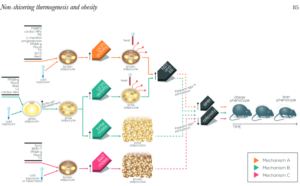 Valente A, Jamurtas AZ, Koutedakis Y, Flouris AD. Molecular pathways linking non-shivering thermogenesis and obesity: focusing on brown adipose tissue development. Biol Rev Camb Philos Soc. 2015 Feb;90(1):77-88. doi: 10.1111/brv.12099. Epub 2014 Apr 7. PMID: 24708171.
Valente A, Jamurtas AZ, Koutedakis Y, Flouris AD. Molecular pathways linking non-shivering thermogenesis and obesity: focusing on brown adipose tissue development. Biol Rev Camb Philos Soc. 2015 Feb;90(1):77-88. doi: 10.1111/brv.12099. Epub 2014 Apr 7. PMID: 24708171.
Abstract:
An increase in energy intake and/or a decrease in energy expenditure lead to fat storage, causing overweight and obesity phenotypes. The objective of this review was to analyse, for the first time using a systematic approach, all published evidence from the past 8 years regarding the molecular pathways linking non-shivering thermogenesis and obesity in mammals, focusing on mechanisms involved in brown adipose tissue development.
Two major databases were scanned from 2006 to 2013 using ‘brown adipose tissue’ AND ‘uncoupling protein-1’ AND ‘mammalian thermoregulation’ AND ‘obesity’ as key words. A total of 61 articles were retrieved using the search criteria. The available research used knockout methodologies, various substances, molecules and agonist treatments, or different temperature and diet conditions, to assess the molecular pathways linking non-shivering thermogenesis and obesity. By integrating the results of the evaluated animal and human studies, our analysis identified specific molecules that enhance non-shivering thermogenesis and metabolism by: (i) stimulating ‘brite’ (brown-like) cell development in white adipose tissue; (ii) increasing uncoupling protein-1 expression in brite adipocytes; and (iii) augmenting brown and/or brite adipose tissue mass.
The latter can be also increased through low temperature, hibernation and/or molecules involved in brown adipocyte differentiation. Cold stimuli and/or certain molecules activate uncoupling protein-1 in the existing brown adipocytes, thus increasing total energy expenditure by a magnitude proportional to the number of available brown adipocytes. Future research should address the interplay between body mass, brown adipose tissue mass, as well as the main molecules involved in brite cell development.
Full Text Link:
https://pubmed.ncbi.nlm.nih.gov/24708171/
![]()
